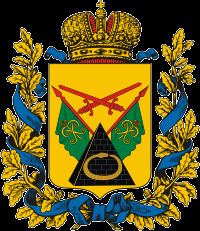1802–1925 → Established 27 February 1802 Political subdivisions uezds 15 (1803) | Disestablished 1 August 1925 | |
 | ||
The Poltava Governorate (Russian: Полтавская губернiя; translit.: Poltavskaya guberniya, Ukrainian: Полтавська Губернія) or Government of Poltava was a guberniya in the historical Left-bank Ukraine region of the Russian Empire, which was officially created in 1802 from the disbanded Malorossiya Governorate which was split between the Chernigov Governorate and Poltava Governorate with an administrative center of Poltava.
Contents
Administrative division
It was administered by 15 uezds (povits):
Most of these ended up in the modern Poltava Oblast of Ukraine, although some: Zolotonosha, Konstantinograd, Pereyaslav and Romny are now part of Cherkasy, Kharkiv, Kiev and Sumy Oblasts respectively.
The Poltava Governorate covered a total area of 49,365 km², and had a population of 2,778,151 according to the 1897 Russian Empire census. It was bordering the following Russian Governorates: Chernigov Governorate and Kursk Governorate to the north, Kiev Governorate to the west, Kharkov Governorate to the east, Kherson Governorate and Yekaterinoslav Governorate to the south. In 1914, the population was 2,794,727. After the formation of the Ukrainian SSR, the territory was wholly included into the new Soviet Republic. Initially the governorate system was retained although variations included the Kremenchug Governorate which was temporarily formed on its territory (August 1920 – December 1922), and the passing of the Pereyaslav uezd to the Kiev Governorate. However, on Third of June 1925 the guberniya was liquidated and replaced by five okrugs (which already were the uyezd subdivision as of seventh of March 1923): Kremenchutsky, Lubensky, Poltavsky, Prylutsky and Romensky (the rest two okrugs existed within the guberniya, Zolotonoshsky and Krasnohradsky, were also liquidated).
Principal cities
Russian Census of 1897, the cities of more than 10,000 people. In bold are the cities of over 50,000.
